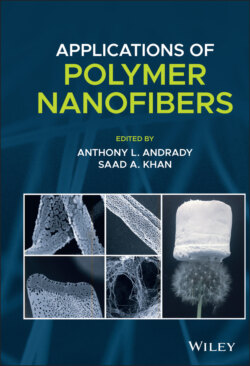Читать книгу Applications of Polymer Nanofibers - Группа авторов - Страница 44
2.4.1 Nanofibrous Nonwoven Fabrics
ОглавлениеNanofiber nonwoven fabrics can be directly produced through nanofiber spinning process (e.g. electrospinning, centrifugal spinning), whereafter randomly stacked nanofiber fabrics can be collected. With the scale‐up of spinning capability, the commercialized production of nanofiber nonwoven fabrics is no longer a fantasy (Zhou and Gong 2008). Also, nanofiber nonwoven fabrics have been studied for many applications, such as filtrations, tissue engineering scaffolds, release control, catalyst, and enzyme carriers, sensors, and energy storage (Feng 2017; Zhu et al. 2016; Yanilmaz et al. 2016).
Nonwoven fabrics can be categorized into single layer and multilayers. Yanilmaz et al. prepared a thin silica/PAN nanofiber fabric as a separator for secondary batteries by electrospinning (Yanilmaz et al. 2016). Briefly, PAN was first dissolved in dimethylformamide (DMF) to form 10 wt% PAN solution. Meanwhile, tetraethyl orthosilicate (TEOS) was dissolved in DMF and HCl solution (37 wt% in water) for generating SiO2. Then TEOS solution was added to the PAN solution to obtain a homogeneous precursor followed by electrospinning into nanofibers with a flow rate of 0.75 ml/h, a voltage of 16 kV, and a tip‐to‐collector distance of 25 cm. PAN nanofiber nonwoven separator possessed higher porosity and better wettability compared with traditional microporous polyolefin membranes. The addition of SiO2 into the nanofiber nonwoven was for giving separators higher electrochemical oxidation limit, larger liquid electrolyte uptake, and lower interfacial resistance. The thickness of electrospun nanofiber fabrics was about 65 μm. With the increment of SiO2, the diameter of electrospun nanofibers was decreased from 324 to 308, 246, and 187 nm when the proportion of SiO2 was adding to 16, 19, and 27 wt%, while the tensile strength decreased from 4.5 to 3.5 MPa. Hassan et al. fabricated self‐bonded nonwoven fabrics directly from polymer resins by melt blowing process, shown in Figure 2.12 (Hassan et al. 2013). The resin was first poured into the extruder and melt with the increment of heating temperature. When the molten was squeezed from the spinneret, the high‐velocity air was conducted and the drag force stretched the fiber rapidly, which reduced the fiber diameter to 0.5–10 μm. Fibers were then gathered on the drum collector to form nonwoven fabrics.
There are also multilayer fabrics, which attach nanofiber nonwoven onto standard fabrics to achieve higher strength or for specialized applications. Lee et al. incorporated an electrospun PU fiber layer onto a PP nonwoven for use in protective clothing systems for agricultural workers (Lee and Obendorf 2007a). In this work, a nonwoven PP layer was used as a substrate and electrospun PU fibers were made from PE‐based thermoplastic PU dissolved in DMF. As shown in Figure 2.13, nanofibers with the average diameter of around 300 nm were covered onto the substrate. Nanofiber nonwoven fabrics were often used as protective textile barriers for preventing liquid penetration (Lee and Obendorf 2007b). Bagherzadeh et al. combined electrospun nanofibers with woven sheets to develop a water repellent breathable fabric. PAN was dissolved in DMF and electrospun to form a nanofiber layer, which was placed between two woven sheets to form a sandwich structure (Bagherzadeh et al. 2011).
Figure 2.12 Melt blowing process for producing nanofiber nonwovens.
Source: Hassan et al. (2013).
Figure 2.13 Layered fabric structure containing electrospun PU nanofibers.
Source: Reproduced with permission from Lee and Obendorf (2007b). Copyright 2007, Springer.
